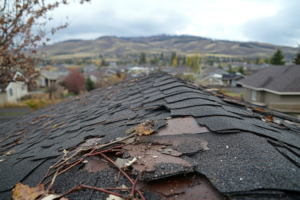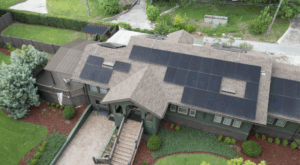Attic ventilation is more than just a technical detail; it’s essential for your home’s health and efficiency. Proper attic ventilation helps regulate temperature, prevent moisture buildup, and extend the lifespan of your roof. In this comprehensive attic ventilation guide, we’ll explain the importance of attic ventilation, how to achieve proper ventilation, and essential tips to keep your home comfortable and protected year-round.
Why Attic Ventilation Matters
Attic ventilation isn’t something to overlook—it’s critical for your roof’s integrity and your home’s comfort. Without it, you could face various issues impacting your living space and roofing system. Here’s how proper attic ventilation benefits your home:
- Regulates Temperature: In the summer, a poorly ventilated attic can trap heat, forcing your air conditioning system to work harder and driving up cooling costs. In winter, inadequate ventilation causes heat to build up, potentially causing snow on your roof to melt unevenly and form ice dams.
- Prevents Moisture Buildup: Activities like cooking and bathing introduce moisture into your attic. This moisture can lead to mold growth, wood rot, and damage to insulation and roofing materials without proper ventilation. Adequate ventilation helps manage and push out this moisture.
- Extends Roof Lifespan: Excessive heat and moisture can accelerate the deterioration of roofing materials. Proper ventilation helps to balance these factors, ultimately extending your roof’s life and reducing the need for costly repairs or replacements.
Natural Attic Ventilation
It may seem counterintuitive to add insulation for warmth while allowing cold air to flow into the attic through vents. Yet, this combination is key to a durable and energy-efficient home.
In winter, letting natural outdoor airflow into the attic helps keep it cold, reducing the risk of ice damming. Ice dams form when snow melts from a warm attic and then re-freezes at the gutters, potentially causing damage. Proper insulation and air sealing help keep attics cold by blocking heat and moist air from below. In summer, adequate ventilation allows super-heated air to escape, protecting roof shingles and removing moisture. The insulation will resist heat transfer into the house.
Check out the Energy Star guide on attic ventilation to learn more about natural ventilation and its benefits.
Key Components of Proper Attic Ventilation
Proper attic ventilation requires understanding its key components and how they work together. Here’s a breakdown:
- Intake Vents: Positioned at the lower part of the roof, typically along the eaves, intake vents let cooler outside air into the attic. This is crucial for promoting airflow and reducing heat buildup. Common intake vents include soffit vents and continuous eave vents.
- Exhaust Vents: Installed higher up on the roof, exhaust vents allow hot air and moisture to escape from the attic. Proper placement of exhaust vents ensures that hot air is effectively pushed out, preventing heat buildup. Types of exhaust vents include ridge vents, gable vents, and turbine vents.
- Ventilation Ratio: A balanced ventilation system requires a correct intake-to-exhaust vents ratio. The general rule is a 1:1 ratio—every square foot of intake ventilation should be matched by an equal amount of exhaust ventilation. This balance ensures optimal airflow and effective temperature regulation.
Visit GAF for guidance on selecting and installing the best ventilation products. As a leading manufacturer of roofing solutions, GAF offers valuable resources to help you understand the latest in roofing technology and ventilation systems.
Attic Ventilation Tips for Optimal Performance
Here are some practical tips for maintaining an effective attic ventilation system:
- Ensure Proper Placement: Properly place intake and exhaust vents. Intake vents should go along the eaves or soffits, while exhaust vents must be positioned at the peak or higher sections of the roof. This arrangement promotes natural airflow and prevents stagnation.
- Maintain Clear Pathways: Ensure that insulation, storage items, or other obstructions do not block airflow around the intake and exhaust vents. Use insulation baffles to direct airflow and keep the system running smoothly.
- Regular Inspections: Periodically inspect your attic to ensure that vents aren’t blocked by debris, pests, or damaged materials. Regular maintenance helps to keep the ventilation system in good shape and prevents potential issues.
- Consider Professional Assessment: If you’re unsure about the effectiveness of your attic ventilation or if you notice problems like excessive heat or moisture, consult a professional roofing contractor. They can assess your current system, suggest improvements, and ensure your attic ventilation meets industry standards. To set up a free inspection with our experienced team at AGU Roofing & Solar, contact us today.
- Upgrade Ventilation as Needed: If your home has undergone remodeling or is experiencing issues, consider upgrading to modern ventilation solutions. Newer technologies and products can offer enhanced performance and efficiency.
Proper attic ventilation is essential for keeping your home’s environment healthy and protecting your investment. By understanding the components of an effective ventilation system and applying these attic ventilation tips, you can ensure your home remains comfortable and well-protected against the elements. Regular maintenance and professional assessments can enhance your attic’s performance, leading to a longer-lasting roofing system.Contact us today for more information on attic ventilation or to schedule a free inspection with our experienced team at AGU Roofing & Solar. We are committed to providing top-notch service and keeping your roofing system in excellent condition.



